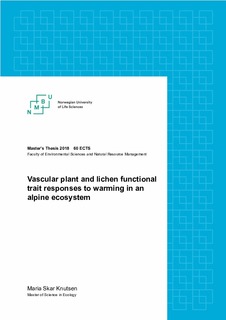| dc.description.abstract | Functional traits are recognized as potential predictors of plant community responses to climate change. In stressful alpine environments, temperature is a limiting factor and may select for resource conservative individuals. Increasing temperature may, therefore, cause a shift in alpine plant community-level traits towards levels associated with higher resource acquisition. This study addresses the functional trait responses of both vascular plants and lichens in an alpine community to climate change and attempts to assess the relative importance of species turnover vs. intraspecific variation in explaining the total community-level trait variation. Several recent studies have dealt with these responses in vascular plant communities but less is known of the community-level trait responses of lichens to climate change, despite their definite ecological importance in alpine ecosystems. I conducted an open top chamber (OTC) experiment at 1500 m elevation at Finse, Western Norway. Along with coverage data for all species in all plots of both treatments (control and OTC), several functional traits of both vascular plants and lichens were measured. From this, community-weighted mean trait values were calculated and further used to study the responses at the whole community level to the increased warming in the OTC treatment. Only vascular plant traits responded at the community level, for which specific leaf area (SLA) and nitrogen content (N) decreased and carbon to nitrogen ratio (C:N) increased with warming. In contrast with my expectations, these results indicate a shift in vascular plant traits towards levels associated with higher resource conservation. Lichen functional traits did not respond to warming at the whole community level. I, however, found variation between treatments in several traits in two of the lichen species, although with contrasting responses, implying intraspecific variation in the lichen community. By decomposing the total community-weighted trait variation, I showed that intraspecific variation was the single significant contributor to the changes observed for all three community-weighted traits that responded to the increased temperature in the OTCs. These results highlight the importance of taking intraspecific trait variation into account in order to reveal the community-level responses of vascular plants and lichens to climate change. | nb_NO |

